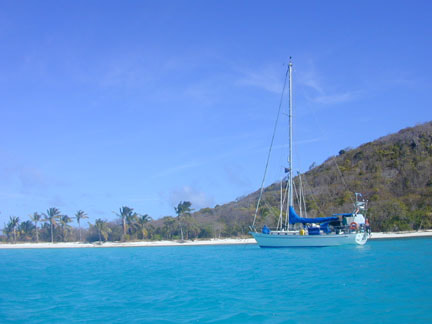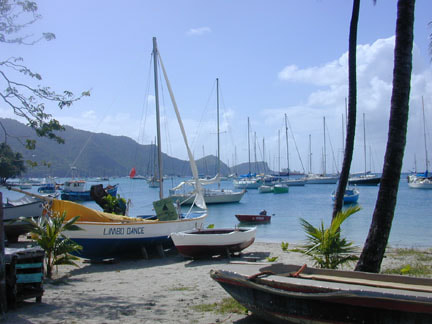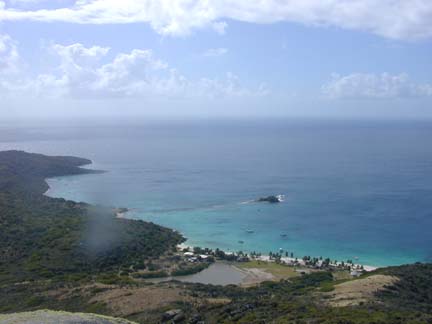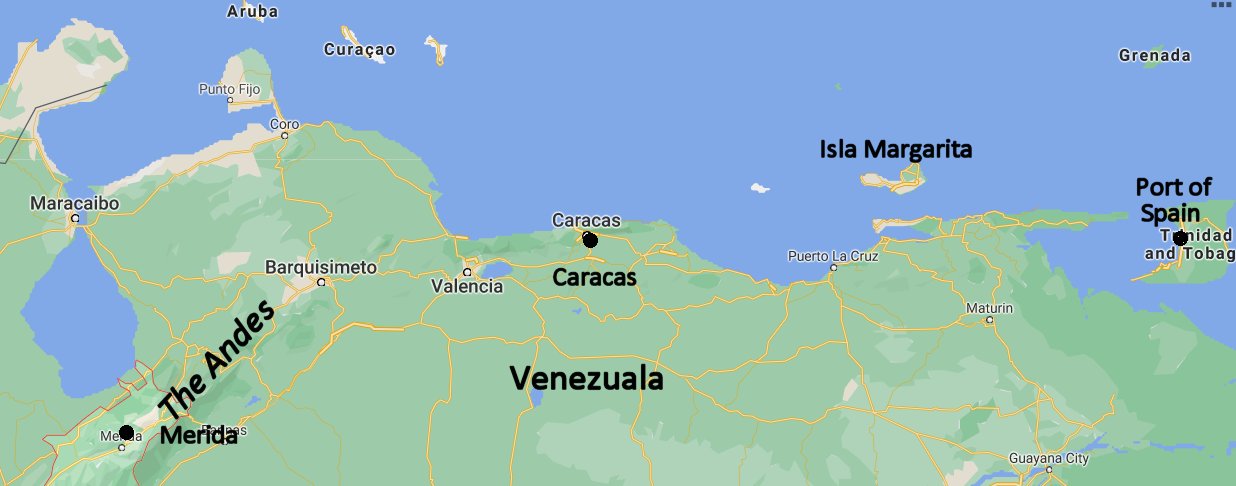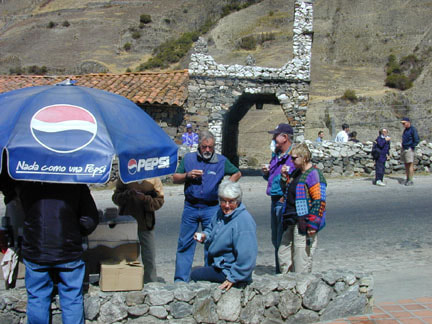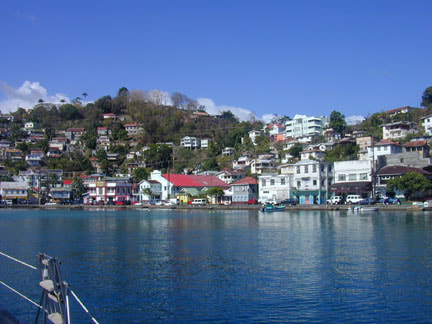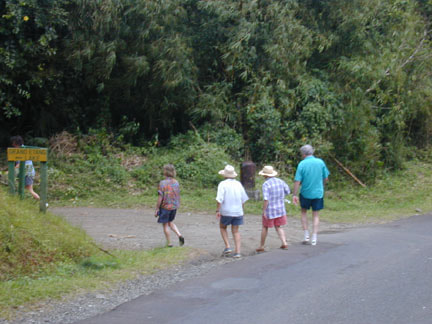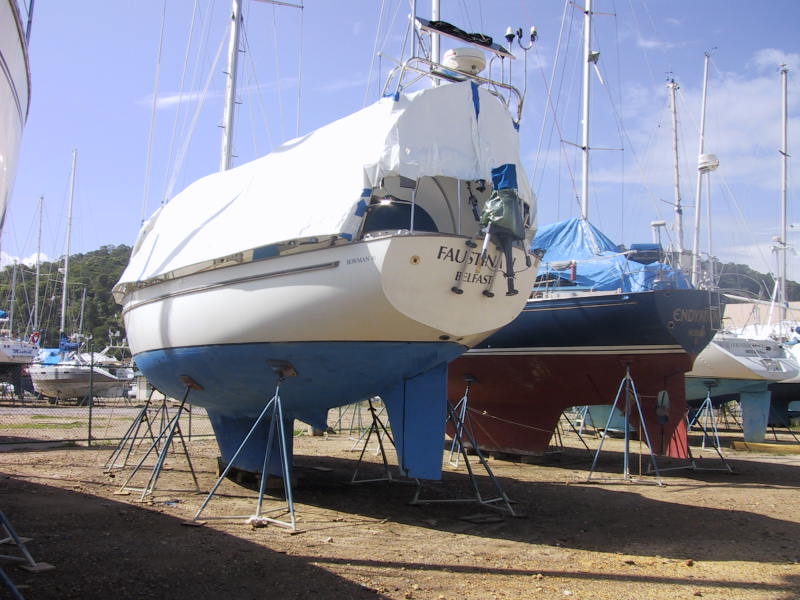After the ARC
Crew: John, Ann, Peter R and Stuart O
Having completed the ARC (see previous log) we were joined by Evie (Peter's wife). We remained in Rodney Bay marina on St Lucia for eight days, joining several ARC parties and attending seminars on weather, West Indian cooking and so on. We toured the island and met many local people – all happy and mostly rather poor. I did the Open Water part of my Scuba course (started in NI) which involved two dives to about 20 metres. It rained hard that day and it was warmer in the water than out of it. We listened to more 'pan bands' and I was hooked!
Crew: John, Ann, Peter R and Stuart O
Having completed the ARC (see previous log) we were joined by Evie (Peter's wife). We remained in Rodney Bay marina on St Lucia for eight days, joining several ARC parties and attending seminars on weather, West Indian cooking and so on. We toured the island and met many local people – all happy and mostly rather poor. I did the Open Water part of my Scuba course (started in NI) which involved two dives to about 20 metres. It rained hard that day and it was warmer in the water than out of it. We listened to more 'pan bands' and I was hooked!
We left Rodney Harbour marina on 17th Dec and headed south along the St Lucia coast to Marigot Bay, a beautiful and mostly hidden inlet where we waited while Stuart went to the airport at the south of the island to collect his wife Yvonne who was to join us for Christmas. Then we moved on south, passing through the rather turbulent seas between St Lucia and St Vincent. We were keen to get on to Bequia and so we passed quickly along the west coat of St Vincent and. with a severe squall crashing about us, we slipped into Admiralty Bay, Bequia in the gathering gloom.
Christmas at Bequia
The next two weeks are not concerned with sailing and so no detail appears hers here. Suffice to say that we had rented three villas on Bequia overlooking Friendship Bay in the south of the island where we were joined by Ann’s children and youmg grandchildren. Ann’s son in law Neil cooked a wonderful Christmas lunch for us – 10 lobsters rather than turkey! A very happy time was had by all.
Christmas at Bequia
The next two weeks are not concerned with sailing and so no detail appears hers here. Suffice to say that we had rented three villas on Bequia overlooking Friendship Bay in the south of the island where we were joined by Ann’s children and youmg grandchildren. Ann’s son in law Neil cooked a wonderful Christmas lunch for us – 10 lobsters rather than turkey! A very happy time was had by all.
The Windward Islands
Ann and I said our farewells to our crew and to our families on 31 Dec and in quite heavy weather, with two reefs in the Main, we went south. We had a lunch stop at Canouan Is but ended the day at Salt Water Bay on Mayreux Is. This lovely palm tree lined bay has room for only about 15 boats at anchor and at its head there is a hotel completely hidden from the sea. It was New Year’s Eve and we decided that we were quite glad that we couldn’t get a table for dinner as it cost about EC$150 (about £40) a head plus, of course drinks. Not expensive by UK standards but very much so for the WI – and we were trying not to be too extravagant. Ann did her usual catering miracle on board.
On New Year’s Day we beat across to Tobago Cays in a westerly F6-7. Quite fresh! But warm. No oilskins required. We anchored between Petit Bateau and Petit Rameau, two of the small islands that stand to the west of the great horseshoe reef that is Tobago Cays. It was too rough to stay long so we made our way through the southern passage between the reefs (the first that we had seen) over to Union Island.
Ann and I said our farewells to our crew and to our families on 31 Dec and in quite heavy weather, with two reefs in the Main, we went south. We had a lunch stop at Canouan Is but ended the day at Salt Water Bay on Mayreux Is. This lovely palm tree lined bay has room for only about 15 boats at anchor and at its head there is a hotel completely hidden from the sea. It was New Year’s Eve and we decided that we were quite glad that we couldn’t get a table for dinner as it cost about EC$150 (about £40) a head plus, of course drinks. Not expensive by UK standards but very much so for the WI – and we were trying not to be too extravagant. Ann did her usual catering miracle on board.
On New Year’s Day we beat across to Tobago Cays in a westerly F6-7. Quite fresh! But warm. No oilskins required. We anchored between Petit Bateau and Petit Rameau, two of the small islands that stand to the west of the great horseshoe reef that is Tobago Cays. It was too rough to stay long so we made our way through the southern passage between the reefs (the first that we had seen) over to Union Island.
Customs and Immigration
These feature a lot while cruising in the WI. They are a major hindrance when cruising between the islands. Already between ‘St Lucia’ and ‘St Vincent and the Grenadines’ (to give the latter its full title) we had had to clear out of St Lucia at Marigot Bay and book into St Vincent, which we did at Bequia. To move south we now had to clear out of Union Is and later book into Grenada – usually done at Carriacou or at either Prickly Bay or Secret Harbour in Grenada. Clearing in is not a task to be taken lightly, nor can it be rushed.
The system is slow and pedantic- and totally unconcerned for the traveller. As we moved around, we became more skilled at the task and learnt where to go and how best to deal with the officials. An example at Union Island sets the scene well. Although there is a Customs office at the harbour at Clifton it is usual for the yachts to be dealt with at the airport which is only 400 metres away. At the office there, as everywhere, one attends Customs before Immigration. Having prepared the yacht's crew list in duplicate and obtained exactly the right amount of money (as no change is ever available) one enters the airport. You have to be 'in the know' to have the confidence to walk through a door marked ‘No Entry – authorised persons only’, but this is the correct thing to do. During the cricket test matches it was hard to get an official to take his eyes off the TV screen which was often placed above the entrance door behind you. You MUST knock and wait for a call to enter. A polite Good Morning is important. The official might glance at you and in due course might look at the papers offered. There is much discussion about the cricket (not with you of course). The whole process would probably require an hour – provided that the forms and money are correct – and the WI are winning the cricket! They charge overtime at weekends and after hours. The completed papers for this and previous years are usually to be seen in piles on the floor at the back of the office.
These feature a lot while cruising in the WI. They are a major hindrance when cruising between the islands. Already between ‘St Lucia’ and ‘St Vincent and the Grenadines’ (to give the latter its full title) we had had to clear out of St Lucia at Marigot Bay and book into St Vincent, which we did at Bequia. To move south we now had to clear out of Union Is and later book into Grenada – usually done at Carriacou or at either Prickly Bay or Secret Harbour in Grenada. Clearing in is not a task to be taken lightly, nor can it be rushed.
The system is slow and pedantic- and totally unconcerned for the traveller. As we moved around, we became more skilled at the task and learnt where to go and how best to deal with the officials. An example at Union Island sets the scene well. Although there is a Customs office at the harbour at Clifton it is usual for the yachts to be dealt with at the airport which is only 400 metres away. At the office there, as everywhere, one attends Customs before Immigration. Having prepared the yacht's crew list in duplicate and obtained exactly the right amount of money (as no change is ever available) one enters the airport. You have to be 'in the know' to have the confidence to walk through a door marked ‘No Entry – authorised persons only’, but this is the correct thing to do. During the cricket test matches it was hard to get an official to take his eyes off the TV screen which was often placed above the entrance door behind you. You MUST knock and wait for a call to enter. A polite Good Morning is important. The official might glance at you and in due course might look at the papers offered. There is much discussion about the cricket (not with you of course). The whole process would probably require an hour – provided that the forms and money are correct – and the WI are winning the cricket! They charge overtime at weekends and after hours. The completed papers for this and previous years are usually to be seen in piles on the floor at the back of the office.
Drama at Grenada
After a night at anchor in Clifton harbour on Union I, a lovely place protected by a reef, we set off south again In order to keep the wind which always blows from the easterly quadrant, we sailed briskly down the east coast of Grenada rather than the west side which tends to be unpredictably squally or calm. We went along the south coast until we reached Secret Harbour a well-protected bay but which has a tricky entrance to catch the unwary.
We were in Secret Habour cleaning the boat and doing some laundry when we heard a sort of Mayday call on the radio. Apparently, a man had gone overboard from a yacht being delivered to ‘The Moorings’ charter company based in Secret Harbour. The skipper of the boat, coming from the Cape Verde Islands, said that his crewman had been lost about 10 miles off the SE coast of Grenada whilst the rest of the crew were asleep. We immediately went out to help in the search for the man. Sadly, despite the sea being calm that day, he was not found – due in some respects to the incompetence of the local CG and the paucity of other boats that went out to look for him. We got back to our anchorage after dark after a long day of searching.
Trips with our guests
During January 2001 we had several guests (Alex, Jenny & Di) from UK and Ireland join us – and with them we again went north to see the Tobago Cays and took trips around the truly spice island of Grenada. Its nutmegs are said to be the best in the world but these days Indonesia exports more of them. The Tobago Cays are not especially spectacular reefs on a world scale but they are nevertheless wonderful to see and are easily accessed by yacht and then by dinghy. It has a fine ‘wall’ on the east side which drops several hundred metres and which provides fine and safe scuba diving as the current flows constantly onto it from the ocean.
After a night at anchor in Clifton harbour on Union I, a lovely place protected by a reef, we set off south again In order to keep the wind which always blows from the easterly quadrant, we sailed briskly down the east coast of Grenada rather than the west side which tends to be unpredictably squally or calm. We went along the south coast until we reached Secret Harbour a well-protected bay but which has a tricky entrance to catch the unwary.
We were in Secret Habour cleaning the boat and doing some laundry when we heard a sort of Mayday call on the radio. Apparently, a man had gone overboard from a yacht being delivered to ‘The Moorings’ charter company based in Secret Harbour. The skipper of the boat, coming from the Cape Verde Islands, said that his crewman had been lost about 10 miles off the SE coast of Grenada whilst the rest of the crew were asleep. We immediately went out to help in the search for the man. Sadly, despite the sea being calm that day, he was not found – due in some respects to the incompetence of the local CG and the paucity of other boats that went out to look for him. We got back to our anchorage after dark after a long day of searching.
Trips with our guests
During January 2001 we had several guests (Alex, Jenny & Di) from UK and Ireland join us – and with them we again went north to see the Tobago Cays and took trips around the truly spice island of Grenada. Its nutmegs are said to be the best in the world but these days Indonesia exports more of them. The Tobago Cays are not especially spectacular reefs on a world scale but they are nevertheless wonderful to see and are easily accessed by yacht and then by dinghy. It has a fine ‘wall’ on the east side which drops several hundred metres and which provides fine and safe scuba diving as the current flows constantly onto it from the ocean.
We spent many happy and lazy days at the Cays enjoying the sun and the beautiful blue of the seas over the reef. Most days we would take the dinghy to the reef and just snorkel for an hour or so.
We had been warned about the ‘Boat Boys’ – ‘what a nuisance they are – so persistent’. However, we found that by dealing with them with respect and remembering that this is how they earn their living, we had no trouble at all. Indeed, at the Cays they brought bread and other stores to order, and if it was expensive, it at least saved us from the task of having to go over to Union Island, about an hour away, to shop for ourselves. If we said that we needed nothing, they generally left straight away – unless it was to stop and have a chat.
The weather stayed fairly constant all month. The wind, still always from the east, blew at about F4-5, occasionally rising to F6. The sailing is therefore invigorating and often quite exciting, but it is always warm and pleasant. The rum and fruit mixes that had taken over from our more usual G&Ts were exactly right for the climate and brought each day to a proper conclusion. F2 has a permanent mounted Bimini cover to keep the sun’s rays at bay. In general, our preparation of the boat turned out to be just right!
Venezuela
At the end of Jan 2001 friends (John & Angela) from Australia joined us at Chagaramas in in Trinidad. We had agreed with them to take the yacht to Venezuela. After a day or two of settling in we sailed off west to Los Testigos, a delightful collection of small nearly deserted islands lying some 30 miles off the Venezuelan coast. We cleared in temporarily with the CG there and then explored and rested for a couple of days. We then set off for Isla Margarita. A nice ‘downhill’ run of about 45 miles with another five miles going along the coast to the anchorage at Porlamar. We had been advised that it was essential to obtain an agent to clear us into Venezuela and this was easily arranged. We took all our papers to him on the morning after our arrival, together with US$50, and collected them again that evening. Easy if rather expensive. In the meantime, we went ashore. The town was the pits. Unfinished hotels were all about together with rundown buildings and horrendous litter everywhere. All the cars, including the taxis, were rust wrecks. Only the very centre of the town was reasonable.
During the day we had visited a travel agent to see about getting to Merida on the mainland, had a poor lunch at the Hotel Pescador - and then had a idle afternoon on board. There were hundreds of pelicans and rather fewer frigate birds to look at as they flrew back and forth and then, sometimes, rising up in undulating columns, going who knows where!
At the end of Jan 2001 friends (John & Angela) from Australia joined us at Chagaramas in in Trinidad. We had agreed with them to take the yacht to Venezuela. After a day or two of settling in we sailed off west to Los Testigos, a delightful collection of small nearly deserted islands lying some 30 miles off the Venezuelan coast. We cleared in temporarily with the CG there and then explored and rested for a couple of days. We then set off for Isla Margarita. A nice ‘downhill’ run of about 45 miles with another five miles going along the coast to the anchorage at Porlamar. We had been advised that it was essential to obtain an agent to clear us into Venezuela and this was easily arranged. We took all our papers to him on the morning after our arrival, together with US$50, and collected them again that evening. Easy if rather expensive. In the meantime, we went ashore. The town was the pits. Unfinished hotels were all about together with rundown buildings and horrendous litter everywhere. All the cars, including the taxis, were rust wrecks. Only the very centre of the town was reasonable.
During the day we had visited a travel agent to see about getting to Merida on the mainland, had a poor lunch at the Hotel Pescador - and then had a idle afternoon on board. There were hundreds of pelicans and rather fewer frigate birds to look at as they flrew back and forth and then, sometimes, rising up in undulating columns, going who knows where!
Next day (Sat) we decided to leave but we found that we were not able to book out until Monday. We considered the option of leaving the boat in the marina in Porlamar but the manager wouldn't accept it unless there was someone on board, (That seemed strange as no other boats were occupied!) It was clear that nothing could be done until Monday so we gave up and went for lunch to the Pescador restaurant under the the trees by the shore. We had excellent calamares. The ladies had fruit juice and the men drank beer. We then went shopping and later collected Ann's photos for a cost of £55!! Back on board for the evening.
Both Ann and Angela were very ill during the night, being both sick and having the trots. Clearly the fruit juice or the ice therein had been dirty. They remained poorly all next day which we we spent on board at anchor
Both Ann and Angela were very ill during the night, being both sick and having the trots. Clearly the fruit juice or the ice therein had been dirty. They remained poorly all next day which we we spent on board at anchor
We duly arranged our clearance documents on Monday, visited an Internet cafe and had a pizza. We then arranged a tour of the eastern part of the island for the afternoon by car with a driver. We went to La Asuncion, the capital and to the north coast, and it was all very attractive and our view about the island changed considerably. However the die was now caste and we went back on board and had supper there. I decided to leave that evening and we slipped after supper and headed towards the Venezualan coast in order to avoid as far as possible the strong west bound current. I went to bed and left John and Ann on watch.
We approached the coast shortly after midnight as I came on watch and we turned east and stayed near the coast. We motored all day and it was dark again by the time that we passed down the east side of Chacachacare Island where it was quite rough before we turned in to the Gulf. We anchored in Scotland Bay on Trinidad at 1930.
Next morning we we went around to Chagaramas where we cleared Immigration and Customs. We went across to Coral Cove (marina facility) and arranged to have F2 lifted out next day. We also arranged to fly to Merida in Venezuala on Friday. Ann and I went to a pan band seminar that evening.
The next day (Thu) we had a frustrating morning arranging to clear ourselves out of Trinidad while leaving the boat at Coral Cove. That involved much walking back and forth and copious paperwork. However it was done by lunchtime and the boat was lifted out after lunch and her bottom power washed. We cleared the deck of anything movable and put a cover over it.
On Friday the wonderful Jesse James of 'Members Only' taxi service collected us at 0600 and took us to the airport. The flight to Caracas was uneventful. There we moved to the National airport where chaos reigned. Our 1430 flight left at 1630! The flight to Merida was fascinating as we seemed to climb alongside mountain tops and then later descending into Merida with the mountain tops well above us on either side. The airport in Merida seems to lie in the town centre along the floor of the valley.
We approached the coast shortly after midnight as I came on watch and we turned east and stayed near the coast. We motored all day and it was dark again by the time that we passed down the east side of Chacachacare Island where it was quite rough before we turned in to the Gulf. We anchored in Scotland Bay on Trinidad at 1930.
Next morning we we went around to Chagaramas where we cleared Immigration and Customs. We went across to Coral Cove (marina facility) and arranged to have F2 lifted out next day. We also arranged to fly to Merida in Venezuala on Friday. Ann and I went to a pan band seminar that evening.
The next day (Thu) we had a frustrating morning arranging to clear ourselves out of Trinidad while leaving the boat at Coral Cove. That involved much walking back and forth and copious paperwork. However it was done by lunchtime and the boat was lifted out after lunch and her bottom power washed. We cleared the deck of anything movable and put a cover over it.
On Friday the wonderful Jesse James of 'Members Only' taxi service collected us at 0600 and took us to the airport. The flight to Caracas was uneventful. There we moved to the National airport where chaos reigned. Our 1430 flight left at 1630! The flight to Merida was fascinating as we seemed to climb alongside mountain tops and then later descending into Merida with the mountain tops well above us on either side. The airport in Merida seems to lie in the town centre along the floor of the valley.
We stayed in Merida or in the mountains for five really lovely days. Ann and I took the world's longest (12.5kms) and highest (13,000ft) lift near Merida that went in four stages to the top of Pico de Bolivar. Ann went to the third stage and I went to the top. We walked some of the way down but got lost near the bottom and happily found help and were able to get a taxi.
Next day we were joined by some others (all lovely people) and were taken into the mountains on the pan-Andean road. After two hours we reached the highest point of the road in the Sierra Nevada National Park where we hired horses and rode for about 6 kms. Great stuff! Back from that we had a some 'Taste of the Andes' soup - milk, cheese and some meat - and then set off for our hotel, a former monastery'. We were at an altitude of over 3000 metres so there want a lot of oxygen. We spent the day exploring by bus and walking and seeing some captive condors with a wild one visiting too. Then we returned to Merida for a couple of days before flying back to Trinidad - not before we had had some real worry about our baggage at Caracas. An awful airport. (John and Angela left to go to Australia directly from Merida.)
Chagaramas
Chagaramas deserves a few words. It was a US base during the war and it had many facilities going to ruin. Then in the early '80s some entrepreneurs realised that the yachting business was getting bigger and that yachts needed a place to go to during the hurricane season. (The season lasts from about July to October but the effects rarely come south of about the mid-point of Grenada. Thus Chagaramas is free of hurricanes.) They developed some boat yards and trained locals to provide the services required by yachtsmen. The facilities now available are probably only bettered by those available in the US and UK. There are about eight large yards and numerous organisations that carry out specialist work such as laying teak decks, making sails and repairing electronic equipment. There are good chandlers with quick access to anything and all prices for yachts are duty free. It is also close to the airport with good international connections.
Additionally Trinidad has the best carnival in the world!
Home for a while
On 21 February we flew home for a break to see children and grandchildren. We
got back on 20 March together with some friends who were to join us on board.
More voyages to Tobago Cays
We now made three more runs to Tobago Cays with our guests. We did so because, although the islands are wonderful, the jewel in the area is undoubtedly the Cays.
Each voyaage with guests took us firstly fron Trinidad to Grenada, a distance of about 80 miles. We did that once by night but we found that we preferred to go in daylight therby enjoying the sun and the sea. There was always a beam wind from the East though that could vary slightly. This is the windiest part of the Windward islands and there is also a strong west-going current, perticularly near to Trinidad. We could usually manage the inter-island crossings in under 12 hours so if we left at first light or perhaps a little earlier we would be safely at anchor by nightfall. It was usually a lusty wind and an invigorating start for our guests.
Chagaramas deserves a few words. It was a US base during the war and it had many facilities going to ruin. Then in the early '80s some entrepreneurs realised that the yachting business was getting bigger and that yachts needed a place to go to during the hurricane season. (The season lasts from about July to October but the effects rarely come south of about the mid-point of Grenada. Thus Chagaramas is free of hurricanes.) They developed some boat yards and trained locals to provide the services required by yachtsmen. The facilities now available are probably only bettered by those available in the US and UK. There are about eight large yards and numerous organisations that carry out specialist work such as laying teak decks, making sails and repairing electronic equipment. There are good chandlers with quick access to anything and all prices for yachts are duty free. It is also close to the airport with good international connections.
Additionally Trinidad has the best carnival in the world!
Home for a while
On 21 February we flew home for a break to see children and grandchildren. We
got back on 20 March together with some friends who were to join us on board.
More voyages to Tobago Cays
We now made three more runs to Tobago Cays with our guests. We did so because, although the islands are wonderful, the jewel in the area is undoubtedly the Cays.
Each voyaage with guests took us firstly fron Trinidad to Grenada, a distance of about 80 miles. We did that once by night but we found that we preferred to go in daylight therby enjoying the sun and the sea. There was always a beam wind from the East though that could vary slightly. This is the windiest part of the Windward islands and there is also a strong west-going current, perticularly near to Trinidad. We could usually manage the inter-island crossings in under 12 hours so if we left at first light or perhaps a little earlier we would be safely at anchor by nightfall. It was usually a lusty wind and an invigorating start for our guests.
In Grenada we would anchor in either Secret Harbour or Prickly Bay on the south coast, both of which provide good protection and a base from which to explore Grenada. There are a few alternatives. One is Hog Bay where the long-term cruisers tend to gather - and vegetate, although they have quite a good time Or one can go near to the airport. Not far up the west coast is St George's, the capital. Here the most obvious place to anchor is the lagoon outside the main harbour (the Carenage) and that is where we would go. However the holding there is poor and once we dragged in a high wind and we hit another boat which was damaged. There are also two yacht clubs there, both of which are welcoming.
In addition to its famous nutnegs, many other trees grow on the island It is a hilly island mostly covered by forest. There are many lakes and waterfalls. We visited a rum distillery which still used the machinery made in the last century in Manchester (UK) to break up sugar canes. Sadly, as the sugar cane fields reduce, rum is increasingly made from molasses.
Sailing along the Grenadian west coast is not really enjoyable due to the fluky winds caused by the high mountains. However once clear of the north end of the island one can head for Isle de Ronde where there is a good day stop for lunch. A nearby rock, reminiscent of Ailsa Crag, called 'Kick 'em Jenny', or more prosaically, 'Diamond Rock' provides no chance of landing but is a wonderful bird sanctuary. Under the sea, about two miles to the West, is an active volcano that erupts every few yew tears - though happily not whilst we were nearby.
And so on North to Carriacou. Here one anchors in Tyrell Bay which has little to offer except a very friendly YC, which is actually a restaurant. You have to go further north to Hillsborough to clear out of Grenada. Hillsborough is an interesting little ramshackle bit of a town where, with the notable exception of the Customs Officers, the people are very friendly. Apparently this is the place to buy duty free goods - not because they are duty free but because they have been smuggled in for the purpose! It is generally considered that the Customs officers connive with the smuggling.
Finally comes the hop to Union Island to clear into 'St Vincent and the Grenadines'. A pleasant occasional diversion can lead one over to Petit Martinique or Petit St Vincent (PSV). The international border runs between these two small islands. Clifton Harbour in Union I is the place to clear into St Vincent. One can get fuel ,water and supplies there. The airport which supports the two-engined aircraft used for island-hopping is almost in the town whilst the other end of the runway ends at the sea. It can be quite alarming to see the aircraft swoop so low over the town.
Sailing along the Grenadian west coast is not really enjoyable due to the fluky winds caused by the high mountains. However once clear of the north end of the island one can head for Isle de Ronde where there is a good day stop for lunch. A nearby rock, reminiscent of Ailsa Crag, called 'Kick 'em Jenny', or more prosaically, 'Diamond Rock' provides no chance of landing but is a wonderful bird sanctuary. Under the sea, about two miles to the West, is an active volcano that erupts every few yew tears - though happily not whilst we were nearby.
And so on North to Carriacou. Here one anchors in Tyrell Bay which has little to offer except a very friendly YC, which is actually a restaurant. You have to go further north to Hillsborough to clear out of Grenada. Hillsborough is an interesting little ramshackle bit of a town where, with the notable exception of the Customs Officers, the people are very friendly. Apparently this is the place to buy duty free goods - not because they are duty free but because they have been smuggled in for the purpose! It is generally considered that the Customs officers connive with the smuggling.
Finally comes the hop to Union Island to clear into 'St Vincent and the Grenadines'. A pleasant occasional diversion can lead one over to Petit Martinique or Petit St Vincent (PSV). The international border runs between these two small islands. Clifton Harbour in Union I is the place to clear into St Vincent. One can get fuel ,water and supplies there. The airport which supports the two-engined aircraft used for island-hopping is almost in the town whilst the other end of the runway ends at the sea. It can be quite alarming to see the aircraft swoop so low over the town.
Trinidad
Back in Trinidad at the end of March between two runs north we had a few days to explore the island. Off the penisular that runs off the NW of the mainland are three small islands which 'guard' the Boca del Dragon (The Dragons Mouth), the name given to the waters between Venezuala and Trinidad. The most westerly of these islands in Chacachacare and it used to be a leper colony. When a cure for leprosy was discovered the doctors, nuns and patients seemed to have left almost overnight as all around the large bay where the dwellings places and surgeries were located there are still buildings standing - some of them beautifully built. In them can be found records and medicines. Many people in Trinidad are frightened to go there but, for some, it makes a nice quiet place to go camping during long holiday weekends On its highest point there is a lighthouse and we befriended the young keeper, Jerome, whom we invited back to the boat one evening. He was late returning to light his lamp!
Back in Trinidad at the end of March between two runs north we had a few days to explore the island. Off the penisular that runs off the NW of the mainland are three small islands which 'guard' the Boca del Dragon (The Dragons Mouth), the name given to the waters between Venezuala and Trinidad. The most westerly of these islands in Chacachacare and it used to be a leper colony. When a cure for leprosy was discovered the doctors, nuns and patients seemed to have left almost overnight as all around the large bay where the dwellings places and surgeries were located there are still buildings standing - some of them beautifully built. In them can be found records and medicines. Many people in Trinidad are frightened to go there but, for some, it makes a nice quiet place to go camping during long holiday weekends On its highest point there is a lighthouse and we befriended the young keeper, Jerome, whom we invited back to the boat one evening. He was late returning to light his lamp!
On the mainland we visted the Asa Wright Nature Reserve. This is based at an old plantation house that was given to the government for the purpose of studying birds. It had rooms for guests. It has a wonderful viewing platform, and guided tours take place twice a day. It is in the northern hills which are covered in trees. About 30 varieties of bird can be observed close too, including several species of Humming Bird that use feeders that guests can stand close to.
Other highlights of out Trinidad exploring were two trips we made to a beach to watch the huge Leatherback turtles come ashore to lay their eggs. The turtles weigh about a ton and their crawl up the beach to dig a hole for the eggs is not an easy one. Mostly they lay at night and its fascinating to see the dark shape appear out of the surf to make its way up the beach, creating unique track marks as it goes. The laying season goes on for several months and there may be 20 or 30 turtles on the beach at the same time. Happily the locals have brought access to the beach by people under control and tourists are well marshalled and briefed. While the turtle is actually laying its eggs it goes into a sort of trance and it is possible without disturbing her, to feel her head and body. Its an unforgettable sight.
Other highlights of out Trinidad exploring were two trips we made to a beach to watch the huge Leatherback turtles come ashore to lay their eggs. The turtles weigh about a ton and their crawl up the beach to dig a hole for the eggs is not an easy one. Mostly they lay at night and its fascinating to see the dark shape appear out of the surf to make its way up the beach, creating unique track marks as it goes. The laying season goes on for several months and there may be 20 or 30 turtles on the beach at the same time. Happily the locals have brought access to the beach by people under control and tourists are well marshalled and briefed. While the turtle is actually laying its eggs it goes into a sort of trance and it is possible without disturbing her, to feel her head and body. Its an unforgettable sight.
Carnival takes place in February. We had sadly missed the main event this year by flying home for our mid-voyage break. However we had become infected with the tension of the build up to it. We had visited several of the bases (pan yards) where the very competitive bands practice. We had previously attended several seminars on Pan and Calypso music. I attended the semi-finals of the National Pan Band competition and had watched eight 100-strong bands playing locally composed music with amazing arrangments. This is genuine 'music of the peeople' and has a raw strength and rythmn that is very infcctious. I'm hooked!
We also attended a splendid concert at an athletic stadium in Port of Spain at which pan band combos played some classical pieces so well that it was truly hard to believe that they were being played only on pans and drums. There were also six gospel choirs together with some girls from a dancing academy. The finale was the Halleluiah chorus, played and sung - and danced to. They do things differently in Trini!
In addition to making visits by land or by sea, another pleasure of the cruising community is the inter-action between boats. Throughout our voyages we met lots of sailors of all ages from many countries. From our many contacts we have drawn a few conclusions. Firstly that most of the couples on boats are either single (mostly having been married to other people) or else on their second marriage - like us. It is perhaps not surprising that the average age would be in the hight 50s - after all that is when folk have the time and resources to take off travelling. Inevitably there are some 'strange' characters but they all have the urge to get off and do their thing. They are all self reliant and interesting - and some have very good stories to tell - and skills to share.
Laying up
Our final run of the year back to Trini was on 28 May - and it was a rough one. We initially thought of turning back to Grenada but we pressed on with reduced sail and had a fast spirited run down to Scotland Bay - and then next day to Chagaramas. We spent a very hot week cleaning the boat and doing repairs or arranging for work to be done whilst we were away home in NI. We hired an air conditioning unit that sat in the hatch above the main cabin and that made life a lot more tolerable. In addition we had a humidifier sent out from UK as, while the boat was laid up, the rainy season would arrive and we wanted to avoid damp mould. We also arranged for the boat to be covered with a shrink wrapped tent to keep the worst of the weather off the teak deck.
In addition to making visits by land or by sea, another pleasure of the cruising community is the inter-action between boats. Throughout our voyages we met lots of sailors of all ages from many countries. From our many contacts we have drawn a few conclusions. Firstly that most of the couples on boats are either single (mostly having been married to other people) or else on their second marriage - like us. It is perhaps not surprising that the average age would be in the hight 50s - after all that is when folk have the time and resources to take off travelling. Inevitably there are some 'strange' characters but they all have the urge to get off and do their thing. They are all self reliant and interesting - and some have very good stories to tell - and skills to share.
Laying up
Our final run of the year back to Trini was on 28 May - and it was a rough one. We initially thought of turning back to Grenada but we pressed on with reduced sail and had a fast spirited run down to Scotland Bay - and then next day to Chagaramas. We spent a very hot week cleaning the boat and doing repairs or arranging for work to be done whilst we were away home in NI. We hired an air conditioning unit that sat in the hatch above the main cabin and that made life a lot more tolerable. In addition we had a humidifier sent out from UK as, while the boat was laid up, the rainy season would arrive and we wanted to avoid damp mould. We also arranged for the boat to be covered with a shrink wrapped tent to keep the worst of the weather off the teak deck.
And so we left F2 at Coral Cove marina in Chagaramas in Trinidad. She had done us extremely well - as usual. She had proved to be a safe and reliable vessel well suited to the task we had given her.
We flew home on 6 June and planned to return in November after the hurricane season.
We flew home on 6 June and planned to return in November after the hurricane season.












